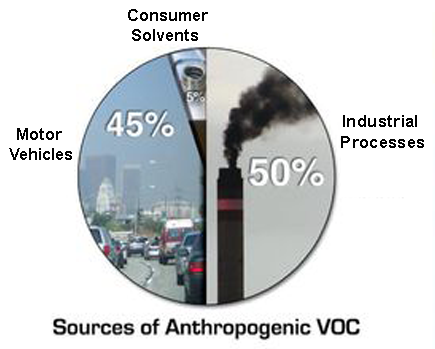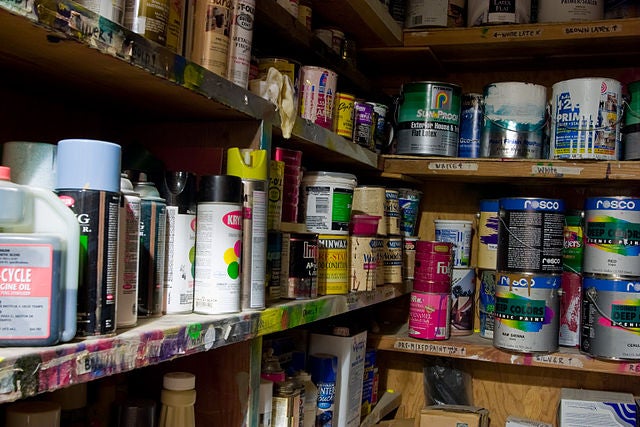Volatile Organic Compounds (VOCs)

Most human-made VOCs come from vehicle exhaust and industrial processes. VOCs that come from consumer solvents have the most impact on indoor air quality.
Volatile Organic Compounds, or VOCs, are organic chemicals that evaporate into the atmosphere at room temperature. Some VOCs can also dissolve into groundwater. They are called organic compounds because they contain the element carbon. There are many types of VOCs. For example, hydrocarbon VOCs have both hydrogen and carbon atoms and include benzene and toluene. Oxygenate VOCs contain carbon, hydrogen, and oxygen, and are a result of car exhaust and atmospheric chemical reactions. Plants make non-harmful VOCs, most commonly terpenes or oils that give some plants their characteristic scent, and forest fires also release VOCs. Some VOCs are toxic and have a negative impact on the atmosphere. VOCs can have both short-term and long-term effects on health, and cause indoor and outdoor air quality to decline.
VOCs Impact Air Quality
VOCs that impact indoor air quality come from many types of household products, including paints and lacquers, paint strippers, cleaning supplies, pesticides, carpet and vinyl flooring, building materials and furnishings, office equipment, and craft materials like glue and markers. Much of the smell associated with these products comes from the VOCs, but off-gassing of VOCs can also be odorless, making them difficult to detect. All of these products can release VOCs while you are using them and when they are stored. Concentrations of VOCs are typically much higher indoors than outdoors. People with asthma, respiratory illness, and chemical sensitivities are most at risk from indoor VOC pollutants.
Gasoline and natural gas are a major source of VOCs that impact outdoor air quality. Vehicle exhaust and burning fossil fuels, wood, and garbage all release VOCs into the atmosphere. VOCs in the air react with sunlight and nitrogen oxides to form tropospheric ozone, another harmful air pollutant. Some VOCs act as greenhouse gases which contribute to climate warming.
VOCs Can Harm Human Health

Paints and household cleaning supplies are sources of VOCs. Using and storing products like paints and household chemicals without adequate ventilation can result in unhealthy levels of VOCs in the air.
Some types of VOCs are more dangerous than others. Benzene is known to cause cancer and found in tobacco smoke, oil and gas, and vehicle exhaust. Polycyclic aromatic hydrocarbons (PAHs) can also cause cancer and are released when coal, oil, and gas are burned. Butadiene is found in gasoline engine exhaust and cigarette smoke and can cause cancer too. Long-term exposure to high levels of VOCs has also been linked to liver, kidney, and nervous system damage. Short-term exposure to VOCs may include symptoms such as dizziness, headache, irritation to the eyes, nose, and throat, nausea, and loss of memory.
Reduce Exposure to VOCs
To help reduce exposure to VOCs, limit the use and storage of VOC containing products in your home, and do not smoke. Buy products, like paint, that are labeled as low VOC. When you must use VOCs, be sure to have adequate ventilation or use them outdoors. Installing air purifiers can help remove VOCs from indoor environments, and adding potted plants to your indoor environment has been shown to reduce levels of some VOCs as well.
© 2020 UCAR with portions adapted from Windows to the Universe (© 2012 NESTA)